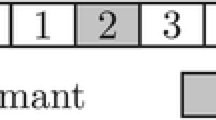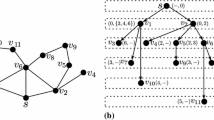Abstract
Energy efficiency is crucial to the implementation of broadcast and multicast services in wireless ad hoc and sensor networks. This paper proposes a path-based power-efficient approach that minimizes energy consumption in the network by optimizing the transmission ranges of all nodes. Unlike existing link-based and node-based solutions, the proposed approach, which is applicable to both static and mobile wireless networks, constructs minimum-power broadcast trees. This study uses Lagrangian Relaxation (LR) to decompose the tree-construction problem, which is NP-complete, into multiple independently solvable sub-problems. The resulting Lagrange dual solution ensures a lower bound on the objective function value. The proposed approximation heuristic solves the primal problem by obtaining the upper bound of the objective value based on the information from the set of Lagrange multipliers. This study develops a decentralized, near-optimal algorithm to solve the problem. Simulation results show that in randomly generated networks, the proposed method outperforms the existing Minimum Shortest Path Tree (MSPT) algorithm, Prim’s Minimum Spanning Tree (PMST) algorithm, and the Broadcast Incremental Power (BIP) algorithm by 30, 10, and 5%, respectively.













Similar content being viewed by others
Notes
Note that this problem formulation requires a given variable of all possible paths P w to determine a path \(p(\in P_w)\) for each destination w. However, not all possible paths P w need to be initially listed because the solution phase of the proposed routing algorithm can select the path of interest from among these paths.
The slot duration is long enough to construct a multicast/broadcast tree so that, after deducting, the lead time \(\Updelta\) is sufficient for message transmission.
References
Papadimitriou, I., & Georgiadis, l. (2006). Minimum-energy broadcasting in multi-hop wireless networks using a single broadcast tree. ACM Mobile Networks and Applications (MONET), 11(3), 361–375.
Cagalj, M., Hubaux, J. P., & Enz, C. (2002). Minimum-energy broadcast in all wireless networks: NP-completeness and distribution issues. In Proceedings of the 8th annual international conference on mobile computing and networking (MobiCom), ACM SIGMOBILE, pp. 172–182.
Wan, P.-J., Calinescu, G., Li, X.-Y., & Frieder, O. (2002). Minimum-energy broadcast routing in static ad hoc wireless networks. Wireless Networks, 8(6), 607–617.
Liang, W. (2002). Constructing minimum-energy broadcast trees in wireless ad hoc networks. In Proceedings of the 3rd ACM international symposium on mobile ad hoc networking and computing (Mobihoc), ACM SIGMOBILE, pp. 112–122.
Liang, W. (2006). Approximate minimum-energy multicasting in wireless ad hoc networks. IEEE Transactions on Mobile Computing, 5(4), 377–387.
Salhieh, A., Weinmann, J., Kochha, M., & Schwiebert, L. (2001). Power efficient topologies for wireless sensor networks. In Proceedings of the 30th international conference on parallel processing (ICPP), pp. 156–163.
Ingelrest, F., & Simplot-Ryl, D. (2008). Localized broadcast incremental power protocol for wireless ad hoc networks. Wireless Networks, 14(3), 309–319.
Dowell, L. J., & Bruno, M. L. (2001). Connectivity of random graphs and mobile networks: Validation of Monte Carlo simulation results. In Proceedings of the 16th ACM Symposium on applied computing (SAC), pp. 77–81.
Montemanni, R., Gambardella, L. M., & Das, A. K. (2005). The minimum power broadcast problem in wireless networks: A simulated annealing approach. In Proceedings of the wireless communications and networking conference (WCNC), IEEE Communication Society, pp. 2057–2062.
Guo, S., & Yang, O. W. W. (2007). Energy-aware multicasting in wireless ad hoc networks: A survey and discussion. Computer Communications, 30(9), 2129–2148.
Li, X. Y., & Wan, P. J. (2001). Constructing minimum energy mobile wireless networks. ACM SIGMOBILE Mobile Computing and Communication Review (MC2R), 5(6), 55–67.
Wieselthier, J. E., Nguyen, G. D., & Ephremides, A. (2000). On the construction of energy-efficient broadcast and multicast trees in wireless networks. In Proceedings of the 19nd annual joint conference of the IEEE Computer and Communications Societies (INFOCOM), IEEE Computer Society, pp. 586–594.
Wieselthier, J. E., Nguyen, G. D., & Ephremides, A. (2001). Algorithms for energy-efficient multicasting in static ad hoc wireless networks. ACM Mobile Networks and Applications (MONET), 6(3), 251–263.
Wieselthier, J. E., Nguyen, G. D., & Ephremides, A. (2002). Energy-efficient broadcast and multicast trees in wireless networks. ACM Mobile Networks and Applications (MONET), 7(2), 481–492.
Flammini, M., Klasing, R., Navarra, A., & Perennes, S. (2008). Tightening the upper bound for the minimum energy broadcasting. Wireless Networks, 14(5), 659–669.
Cheng, M. X., Sun, J., Min, M., Li, Y., & Wu, W. (2006). Energy-efficient broadcast and multicast routing in multihop ad hoc wireless networks. Wireless Communications and Mobile Computing (WCMC), 6(2), 213–223.
Das, A. K., Marks, R. J., El-Sharkawi, M., Arabshahi, P., & Gray, A. (2003). r-shrink: A heuristic for improving minimum power broadcast trees in wireless networks. In Proceedings of the IEEE 2003 global communications conference (GLOBECOM), pp. 523–527.
Min, M., & Pardalos, P. M. (2007). Total energy optimal multicasting in wireless ad hoc networks. Journal of Combinatorial Optimization, 13(4), 365–378.
Das, A. K., Marks, R. J., El-Sharkawi, M., Arabshahi, P., & Gray, A. (2003). Minimum power broadcast trees for wireless networks: Integer programming formulations. In Proceedings of the 22nd annual joint conference of the IEEE Computer and Communications Societies (INFOCOM), IEEE Computer Society, pp. 1001–1110
Ahluwalia, A. S., & Modiano, E. H. (2005). On the complexity and distributed construction of energy-efficient broadcast trees in wireless ad hoc networks. IEEE Transactions on Wireless Communications, 4(5), 2136–2147.
Klasing, R., Navarra, A., Papadopoulos, A., & Perennes, S. (2004). Adaptive Broadcast Consumption (ABC), a new heuristic and new bounds for the minimum energy broadcast routing problem. In Lecture notes in computer science (Vol. 3042, pp. 866–877). Springer.
Cartigny, J., Simplot, D., & Stojmenovic, I. (2003). Localized minimum-energy broadcasting in ad-hoc networks. In Proceedings of the 22nd annual joint conference of the IEEE Computer and Communications Societies (INFOCOM), IEEE Computer Society, pp. 2210–2217.
Camp, T., Boleng, J., & Davies, V. (2002). A survey of mobility models for ad hoc network research. WCMC: Special Issue on Mobile Ad Hoc Networking, 2(5), 483–502.
Liang, B., & Haas, Z. J. (1999). Predictive distance-based mobility management for PCS networks. In Proceedings of the 18nd annual joint conference of the IEEE Computer and Communications Societies (INFOCOM), IEEE Computer Society, pp. 1377–1384.
Fisher, M. L. (1981). The Lagrangian relaxation method for solving integer programming problems. Management Science, 27(1), 1–18.
Boukerche, A., & Vaidya, S. (2003). A performance evaluation of a dynamic source routing discovery optimization protocol using gps system. Telecommunication Systems, 22(1–4), 337–354.
Lee, S. J., Su, W., & Gerla, M. (2002). On-demand multicast routing protocol in multi-hop wireless mobile networks. ACM/Baltzer Mobile Networks and Applications (MONET), 7(6), 441–453.
Box, M. J., Davies, D., & Swann, W. H. (1969). Non-linear optimisation techniques. Edinburgh: Oliver & Boyd.
Held, M., Wolfe, P., & Crowder, H. D. (1974). Validation of subgradient optimization. Math Programming, 6(1), 62–88.
Cormen, T. H., Leiserson, C. E., Rivest, R. L., & Stein, C. (2001). Introduction to algorithms (2nd edn.). MIT Press and McGraw-Hill, 2001. Section 24.1: The Bellman-Ford algorithm, pp. 588–592. ISBN 0-262-03293-7.
Ahuja, R. K., Magnanti, T. L., & Orlin, J. B. (1993). Network flows: Theory, algorithms, and applications. Prentice-Hall, placecountry-region Ch. 16.
Wieselthier, J. E., Nguyen, G. D., & Ephremides, A. (2002). Distributed algorithms for energy-efficient broadcasting in ad hoc networks. In Proceedings of the IEEE military communications conference(MilCom), pp. 820–825.
Wieselthier, J. E., Nguyen, G. D., & Ephremides, A. (2002). The energy efficiency of distributed algorithms for broadcasting in ad hoc networks. In Proceedings of the wireless personal multimedia communications (WPMC), pp. 499–503.
Wen, Y. F. (2007). Performance optimization for algorithms for wireless networks. Ph. D Dissertation, National Taiwan University.
Author information
Authors and Affiliations
Corresponding author
Appendix: The pseudo code of the GIBT algorithm
Appendix: The pseudo code of the GIBT algorithm
Algorithm 1 shows the pseudo code of the Greedy Incremental Broadcast Tree (GIBT) algorithm. This algorithm was implemented in the same manner as the basic version of Prim’s shortest path algorithm, from the destination nodes to any nodes included in the dominated set A. For example, only the source node s initially belongs to the dominated set A. Thus, a selected node must route to node s. Then, other destination nodes only route to a node that belongs to the dominated set A, which is the constructed multicast tree, iteration by iteration. Figure 14 shows an example of the GIBT algorithm, where the destination set W = {8, 9, 10, 11, 12}. In the following step, node 11 only has to select a sub-path 11-6-5 to a node in the existing multicast tree set A = {1, 2, 5, 8, 9, 10}. Finally, node 12 only has to find a sub-path (e.g., 12-11) to the multicast tree set A = {1, 2, 5, 8, 9, 10, 11}.
Rights and permissions
About this article
Cite this article
Wen, YF., Liao, W. Minimum power multicast algorithms for wireless networks with a Lagrangian relaxation approach. Wireless Netw 17, 1401–1421 (2011). https://doi.org/10.1007/s11276-011-0344-9
Published:
Issue Date:
DOI: https://doi.org/10.1007/s11276-011-0344-9





